Human Flow Dataset Reveals Changes in Citizens’ Outing Behaviors including Greenspace Visits before and during the First Wave of the COVID-19 Pandemic in Kanazawa, Japan
Abstract
:1. Introduction
2. Materials and Methods
2.1. Study Area
2.2. The Human Flow Data and Sample
2.3. Analysis Methods
2.3.1. Kanazawa Citizens’ Behavioral Changes
2.3.2. Percentage Increase/Decrease in the Number of Visits to Each Greenspace and Distance Traveled
3. Results
3.1. General Change of Activity Pattern
3.2. Average Number of Outings and Total Time Spent out of the House Per Day
3.3. Maximum Distance from Home to Place of Visit for a Day
3.4. Number of Outings by Means of Transportation
3.5. Number of Visits by Destination
3.6. Percentage Increase/Decrease in the Number of Visits to Each Greenspace and Distance Traveled
4. Discussion
4.1. Number of Outings and Total Time Spent Outside the Home
4.2. Maximum Distance from Home to Place of Visit and Number of Outings by Means of Transportation
4.3. Number of Visits by Destination
4.4. Percentage Increase/Decrease in the Number of Visits to Each Greenspace and Distance Traveled
4.5. Overall Discussion
4.6. Study Limitations
5. Conclusions
Author Contributions
Funding
Institutional Review Board Statement
Informed Consent Statement
Data Availability Statement
Conflicts of Interest
References
- Mell, I. Green infrastructure: Reflections on past, present and future praxis. Landsc. Res. 2017, 42, 135–145. [Google Scholar] [CrossRef] [Green Version]
- Derks, J.; Giessen, L.; Winkel, G. COVID-19-induced visitor boom reveals the importance of forests as critical infrastructure. For. Policy Econ. 2020, 118, 102253. [Google Scholar] [CrossRef]
- Łaszkiewicz, E.; Czembrowski, P.; Kronenberg, J. Creating a Map of the Social Functions of Urban Green Spaces in a City with Poor Availability of Spatial Data: A Sociotope for Lodz. Land 2020, 9, 183. [Google Scholar] [CrossRef]
- Kato, S. Green Infrastructure Planning for Asian Cities: The Planning Strategies, Guidelines, and Recommendations; Springer: Tokyo, Japan, 2021; pp. 353–371. [Google Scholar] [CrossRef]
- Matsler, A.M.; Meerow, S.; Mell, I.C.; Pavao-Zuckerman, M.A. A ‘green’ chameleon: Exploring the many disciplinary definitions, goals, and forms of “green infrastructure”. Landsc. Urban Plan. 2021, 214, 104145. [Google Scholar] [CrossRef]
- Rojas-Rueda, D.; Nieuwenhuijsen, M.J.; Gascon, M.; Perez-Leon, D.; Mudu, P. Green spaces and mortality: A systematic review and meta-analysis of cohort studies. Lancet Planet. Health 2019, 3, e469–e477. [Google Scholar] [CrossRef] [Green Version]
- Grima, N.; Corcoran, W.; Hill-James, C.; Langton, B.; Sommer, H.; Fisher, B. The importance of urban natural areas and urban ecosystem services during the COVID-19 pandemic. PLoS ONE 2020, 15, e0243344. [Google Scholar] [CrossRef]
- Lesser, I.A.; Nienhuis, C.P. The Impact of COVID-19 on Physical Activity Behavior and Well-Being of Canadians. Int. J. Environ. Res. Public Health 2020, 17, 3899. [Google Scholar] [CrossRef]
- Ugolini, F.; Massetti, L.; Calaza-Martínez, P.; Cariñanos, P.; Dobbs, C.; Ostoić, S.K.; Marin, A.M.; Pearlmutter, D.; Saaroni, H.; Šaulienė, I.; et al. Effects of the COVID-19 pandemic on the use and perceptions of urban green space: An international exploratory study. Urban For. Urban Green. 2020, 56, 126888. [Google Scholar] [CrossRef]
- Venter, Z.S.; Barton, D.N.; Gundersen, V.; Figari, H.; Nowell, M. Urban nature in a time of crisis: Recreational use of green space increases during the COVID-19 outbreak in Oslo, Norway. Environ. Res. Lett. 2020, 15, 104075. [Google Scholar] [CrossRef]
- Venter, Z.S.; Barton, D.N.; Gundersen, V.; Figari, H.; Nowell, M.S. Back to nature: Norwegians sustain increased recreational use of urban green space months after the COVID-19 outbreak. Landsc. Urban Plan. 2021, 214, 104175. [Google Scholar] [CrossRef]
- Lu, Y.; Zhao, J.; Wu, X.; Lo, S.M. Escaping to nature during a pandemic: A natural experiment in Asian cities during the COVID-19 pandemic with big social media data. Sci. Total Environ. 2021, 777, 146092. [Google Scholar] [CrossRef]
- Larson, L.R.; Mullenbach, L.E.; Browning, M.H.; Rigolon, A.; Thomsen, J.; Metcalf, E.C.; Reigner, N.P.; Sharaievska, I.; McAnirlin, O.; D’Antonio, A.; et al. Greenspace and park use associated with less emotional distress among college students in the United States during the COVID-19 pandemic. Environ. Res. 2021, 204, 112367. [Google Scholar] [CrossRef]
- Soga, M.; Evans, M.J.; Cox, D.T.C.; Gaston, K.J. Impacts of the COVID-19 pandemic on human–nature interactions: Pathways, evidence and implications. People Nat. 2021, 3, 518–527. [Google Scholar] [CrossRef]
- Zhou, X.; Rana, M.P. Social benefits of urban green space. Manag. Environ. Qual. Int. J. 2012, 23, 173–189. [Google Scholar] [CrossRef]
- Hartig, T.; Mitchell, R.; de Vries, S.; Frumkin, H. Nature and Health. Annu. Rev. Public Health 2014, 35, 207–228. [Google Scholar] [CrossRef] [Green Version]
- Fong, K.C.; Hart, J.E.; James, P. A Review of Epidemiologic Studies on Greenness and Health: Updated Literature Through 2017. Curr. Environ. Health Rep. 2018, 5, 77–87. [Google Scholar] [CrossRef] [Green Version]
- Kondo, M.C.; Fluehr, J.M.; McKeon, T.; Branas, C.C. Urban Green Space and Its Impact on Human Health. Int. J. Environ. Res. Public Health 2018, 15, 445. [Google Scholar] [CrossRef] [Green Version]
- Bratman, G.N.; Anderson, C.B.; Berman, M.G.; Cochran, B.; de Vries, S.; Flanders, J.; Folke, C.; Frumkin, H.; Gross, J.J.; Hartig, T.; et al. Nature and mental health: An ecosystem service perspective. Sci. Adv. 2019, 5, eaax0903. [Google Scholar] [CrossRef] [Green Version]
- Keeler, B.L.; Hamel, P.; McPhearson, T.; Hamann, M.H.; Donahue, M.L.; Prado, K.A.M.; Arkema, K.K.; Bratman, G.N.; Brauman, K.A.; Finlay, J.C.; et al. Social-ecological and technological factors moderate the value of urban nature. Nat. Sustain. 2019, 2, 29–38. [Google Scholar] [CrossRef]
- Nielsen, T.S.; Hansen, K.B. Do green areas affect health? Results from a Danish survey on the use of green areas and health indicators. Health Place 2007, 13, 839–850. [Google Scholar] [CrossRef]
- Soga, M.; Evans, M.J.; Tsuchiya, K.; Fukano, Y. A room with a green view: The importance of nearby nature for mental health during the COVID-19 pandemic. Ecol. Appl. 2020, 31, e2248. [Google Scholar] [CrossRef]
- NHK (No Date) Emergency Declaration-1st Situation. Available online: https://www3.nhk.or.jp/news/special/coronavirus/emergency/ (accessed on 22 February 2021).
- NIKKEI (The Japan Economic Daily). In Europe and the United States, Restrictions on Private Rights, Penalties for Going Out, and Enforcement Differ from Japan. 2020. Available online: https://www.nikkei.com/article/DGXMZO57774880X00C20A4EA1000/ (accessed on 22 February 2021).
- Kashiyama, T.; Sekimoto, Y.; Kuwahara, M.; Mitani, T.; Koshimura, S. Hybrid System for Generating Data on Human Flow in a Tsunami Disaster. J. Disaster Res. 2018, 13, 347–357. [Google Scholar] [CrossRef]
- Yang, X.; Fang, Z.; Xu, Y.; Yin, L.; Li, J.; Lu, S. Spatial heterogeneity in spatial interaction of human movements—Insights from large-scale mobile positioning data. J. Transp. Geogr. 2019, 78, 29–40. [Google Scholar] [CrossRef]
- Kang, Y.; Gao, S.; Liang, Y.; Li, M.; Rao, J.; Kruse, J. Multiscale dynamic human mobility flow dataset in the U.S. during the COVID-19 epidemic. Sci. Data 2020, 7, 390. [Google Scholar] [CrossRef]
- Zhuo, L.; Chen, Z.; Wu, C.; Shi, Q.; Gu, Z.; Tao, H.; Li, Q. Deriving intercity human flow pattern and mechanism based on cell phone location data: Case study of Guangdong Province, China. Comput. Urban Sci. 2022, 2, 4. [Google Scholar] [CrossRef]
- Ueno, Y. Potential of human mobility flow dataset and a new horizon of urban and green space planning research revealed in the COVID-19 pandemic. J. Jpn. Inst. Landsc. Arch. 2021, 85, 242–245. [Google Scholar] [CrossRef]
- Korpilo, S.; Virtanen, T.; Lehvävirta, S. Smartphone GPS tracking—Inexpensive and efficient data collection on recreational movement. Landsc. Urban Plan. 2017, 157, 608–617. [Google Scholar] [CrossRef] [Green Version]
- Takeyama, H.; Wakai, S.; Yamamoto, S.; Yakushiji, T.; Nakase, I. A study on the use of urban parks using location-based big data under the Coronavirus crisis. J. Jpn. Inst. Landsc. Arch. 2021, 84, 475–478. [Google Scholar] [CrossRef]
- Amemiya, M. Identifying changing patterns of people’s use of urban parks due to the COVID-19 pandemic: An analysis using geolocation big data. Rep. City Plan. Inst. Jpn. 2020, 19, 210–213. [Google Scholar] [CrossRef]
- Hu, X.; Shen, P.; Shi, Y.; Zhang, Z. Using Wi-Fi probe and location data to analyze the human distribution characteristics of green spaces: A case study of the Yanfu Greenland Park, China. Urban For. Urban Green. 2020, 54, 126733. [Google Scholar] [CrossRef]
- Marcelo, G.-T.; Constance, B.; Joseph, M.; Kay, A.; David, Z.; Maarten, V.S.; Adrienne, G.-R. Do we have enough recreational spaces during pandemics? An answer based on the analysis of individual mobility patterns in Switzerland. Landsc. Urban Plan. 2022, 221, 104373. [Google Scholar] [CrossRef]
- Thomson, B. The COVID-19 Pandemic. Circulation 2020, 142, 14–16. [Google Scholar] [CrossRef] [Green Version]
- Kanazawa City (No Date) Types of Urban Parks. Available online: https://www4.city.kanazawa.lg.jp/29004/park/syurui.html (accessed on 16 March 2021).
- Ishikawa Prefecture. Circumstances of Infected Patients. 2020. Available online: https://www.pref.ishikawa.lg.jp/kansen/coronakennai2002.html (accessed on 16 March 2021).
- Takeuchi, T.; Hisama, A. Analysis of changes in the number of park users and the facility usage restrictions in Tokyo Metropolitan Parks under the COVID-19 pandemic. J. Jpn. Inst. Landsc. Arch. 2021, 84, 479–484. [Google Scholar] [CrossRef]
- Ugolini, F.; Massetti, L.; Pearlmutter, D.; Sanesi, G. Usage of urban green space and related feelings of deprivation during the COVID-19 lockdown: Lessons learned from an Italian case study. Land Use Policy 2021, 105, 105437. [Google Scholar] [CrossRef]
- Burnett, H.; Olsen, J.R.; Nicholls, N.; Mitchell, R. Change in time spent visiting and experiences of green space following restrictions on movement during the COVID-19 pandemic: A nationally representative cross-sectional study of UK adults. BMJ Open 2021, 11, e044067. [Google Scholar] [CrossRef]
- Korpilo, S.; Kajosaari, A.; Rinne, T.; Hasanzadeh, K.; Raymond, C.M.; Kyttä, M. Coping with Crisis: Green Space Use in Helsinki Before and During the COVID-19 Pandemic. Front. Sustain. Cities 2021, 3, 713977. [Google Scholar] [CrossRef]
- Khalilnezhad, M.R.; Ugolini, F.; Massetti, L. Attitudes and Behaviors toward the Use of Public and Private Green Space during the COVID-19 Pandemic in Iran. Land 2021, 10, 1085. [Google Scholar] [CrossRef]
- Berdejo-Espinola, V.; Suárez-Castro, A.F.; Amano, T.; Fielding, K.S.; Oh, R.R.Y.; Fuller, R.A. Urban green space use during a time of stress: A case study during the COVID-19 pandemic in Brisbane, Australia. People Nat. 2021, 3, 597–609. [Google Scholar] [CrossRef]
- Shimomura, Y.; Masuda, N.; Abe, D.; Yamamoto, S.; Suzuki, K. Study on Resident’s Behavior of Block Park in Neighborhood. J. Jpn. Inst. Landsc. Arch. 1994, 58, 217–220. [Google Scholar] [CrossRef] [Green Version]
- Kaczynski, A.T.; Besenyi, G.M.; Stanis, S.A.W.; Koohsari, M.J.; Oestman, K.B.; Bergstrom, R.; Potwarka, L.R.; Reis, R.S. Are park proximity and park features related to park use and park-based physical activity among adults? Variations by multiple socio-demographic characteristics. Int. J. Behav. Nutr. Phys. Act. 2014, 11, 146. [Google Scholar] [CrossRef] [Green Version]
- Poortinga, W.; Bird, N.; Hallingberg, B.; Phillips, R.; Williams, D. The role of perceived public and private green space in subjective health and wellbeing during and after the first peak of the COVID-19 outbreak. Landsc. Urban Plan. 2021, 211, 104092. [Google Scholar] [CrossRef]
- Lin, B.; Fuller, R.; Bush, R.; Gaston, K.J.; Shanahan, D.F. Opportunity or Orientation? Who Uses Urban Parks and Why. PLoS ONE 2014, 9, e87422. [Google Scholar] [CrossRef] [Green Version]
- Soga, M.; Gaston, K.J. Extinction of experience: The loss of human-nature interactions. Front. Ecol. Environ. 2016, 14, 94–101. [Google Scholar] [CrossRef] [Green Version]
- da Schio, N.; Phillips, A.; Fransen, K.; Wolff, M.; Haase, D.; Ostoić, S.K.; Živojinović, I.; Vuletić, D.; Derks, J.; Davies, C.; et al. The impact of the COVID-19 pandemic on the use of and attitudes towards urban forests and green spaces: Exploring the instigators of change in Belgium. Urban For. Urban Green. 2021, 65, 127305. [Google Scholar] [CrossRef]
- Chadwick, G.F. The Park and the Town: Public Landscape in the 19th and 20th Centuries; F.A. Praeger: New York, NY, USA, 1966. [Google Scholar]
- Wolch, J.R.; Byrne, J.; Newell, J.P. Urban green space, public health, and environmental justice: The challenge of making cities “just green enough”. Landsc. Urban Plan. 2014, 125, 234–244. [Google Scholar] [CrossRef] [Green Version]
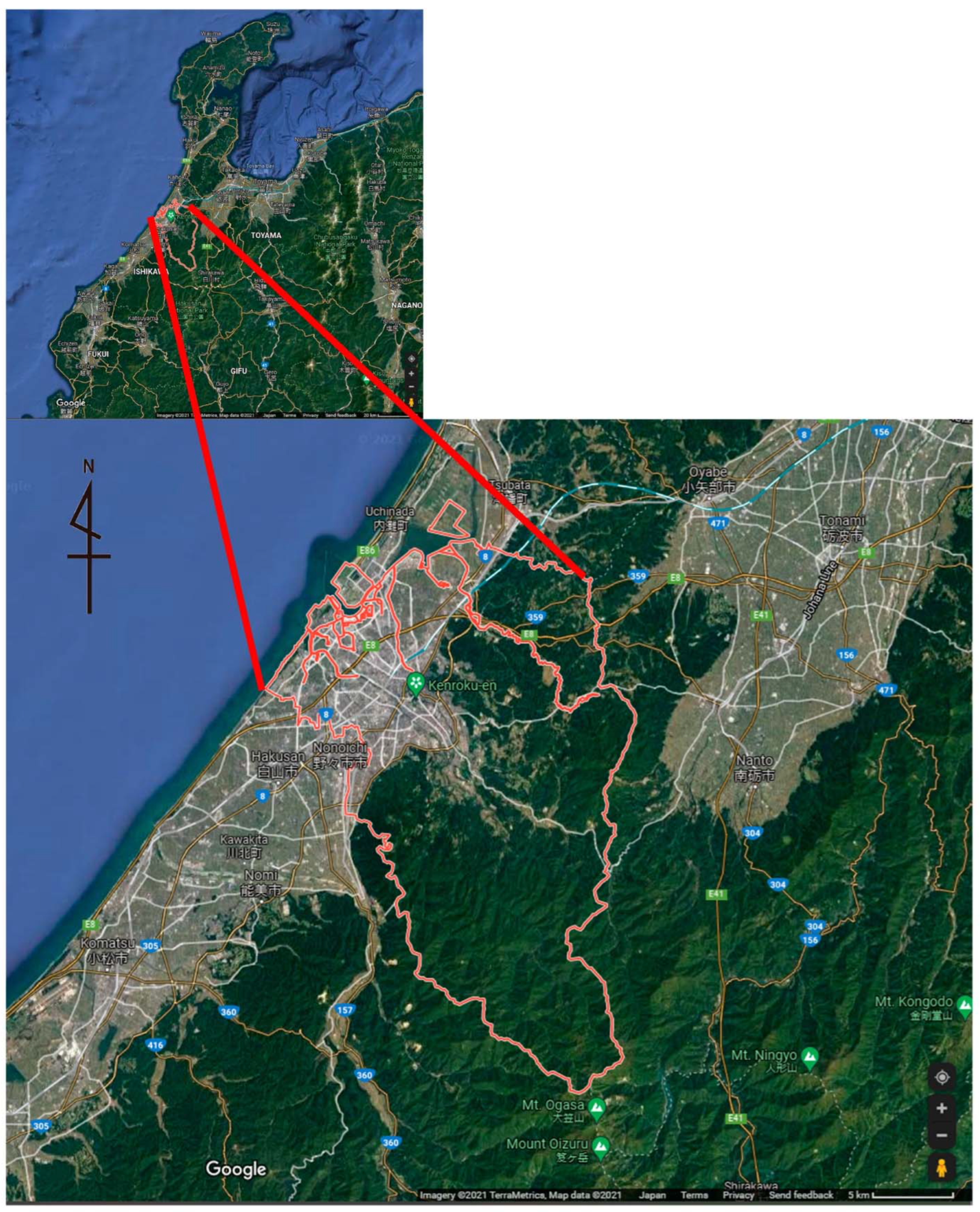
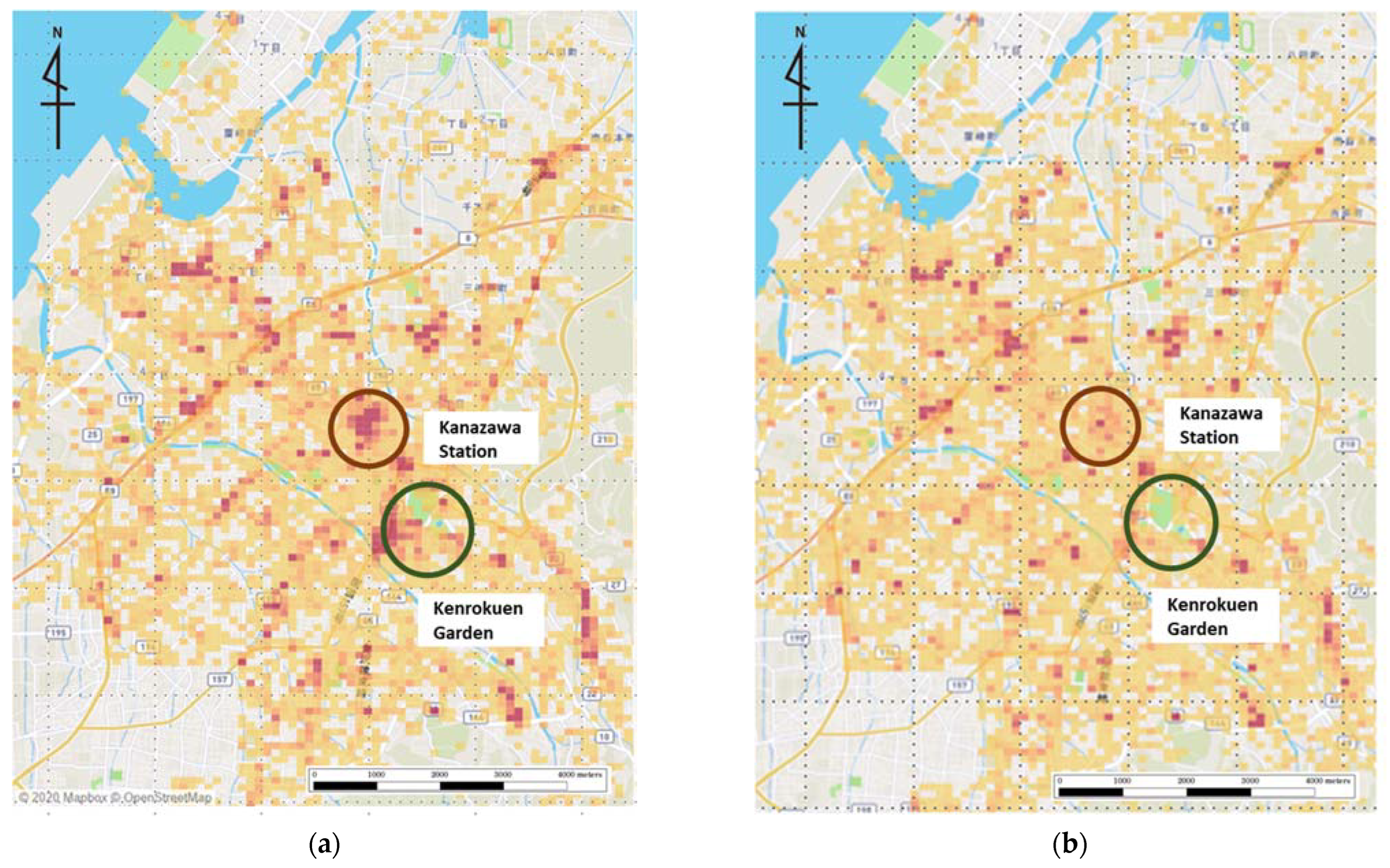
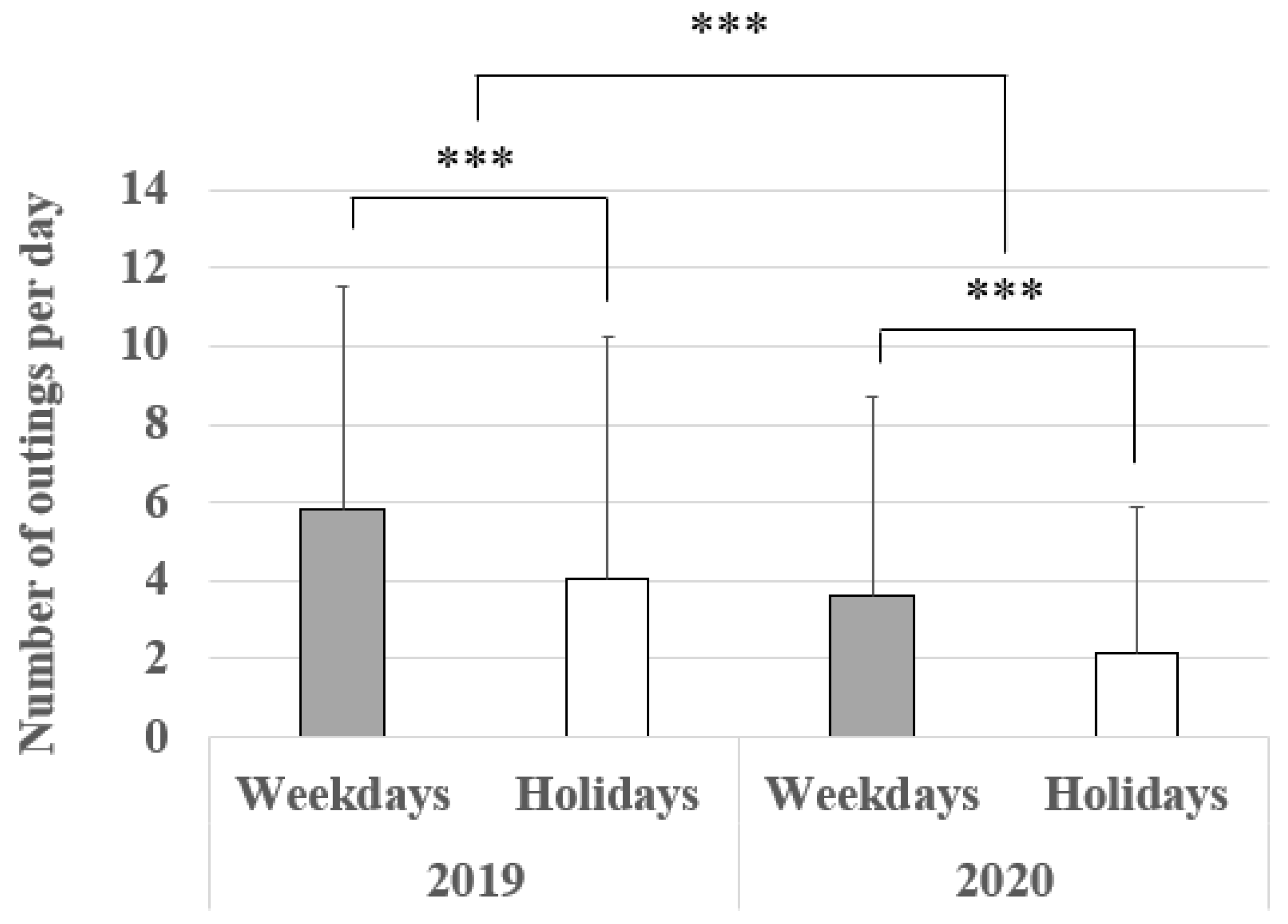
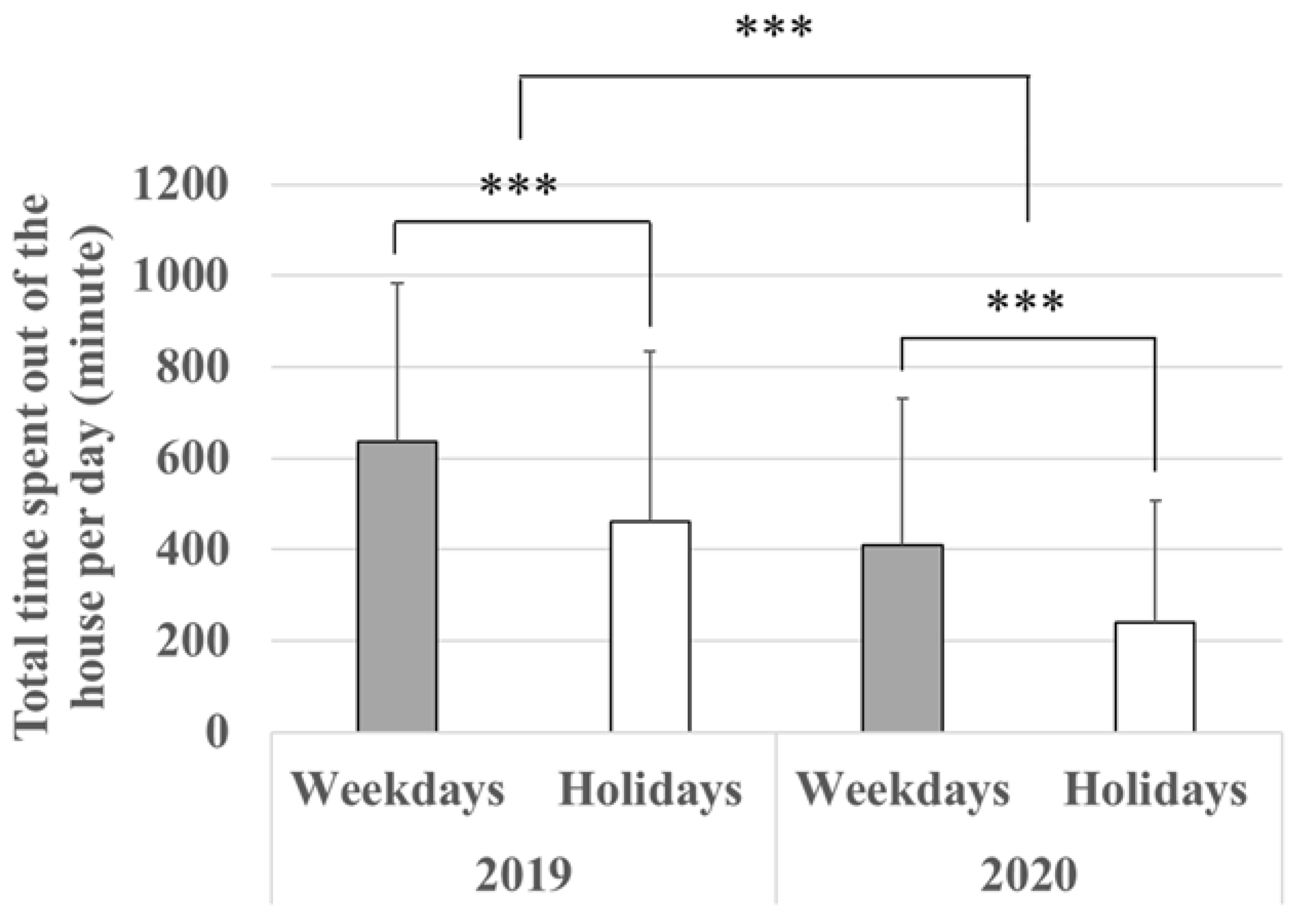
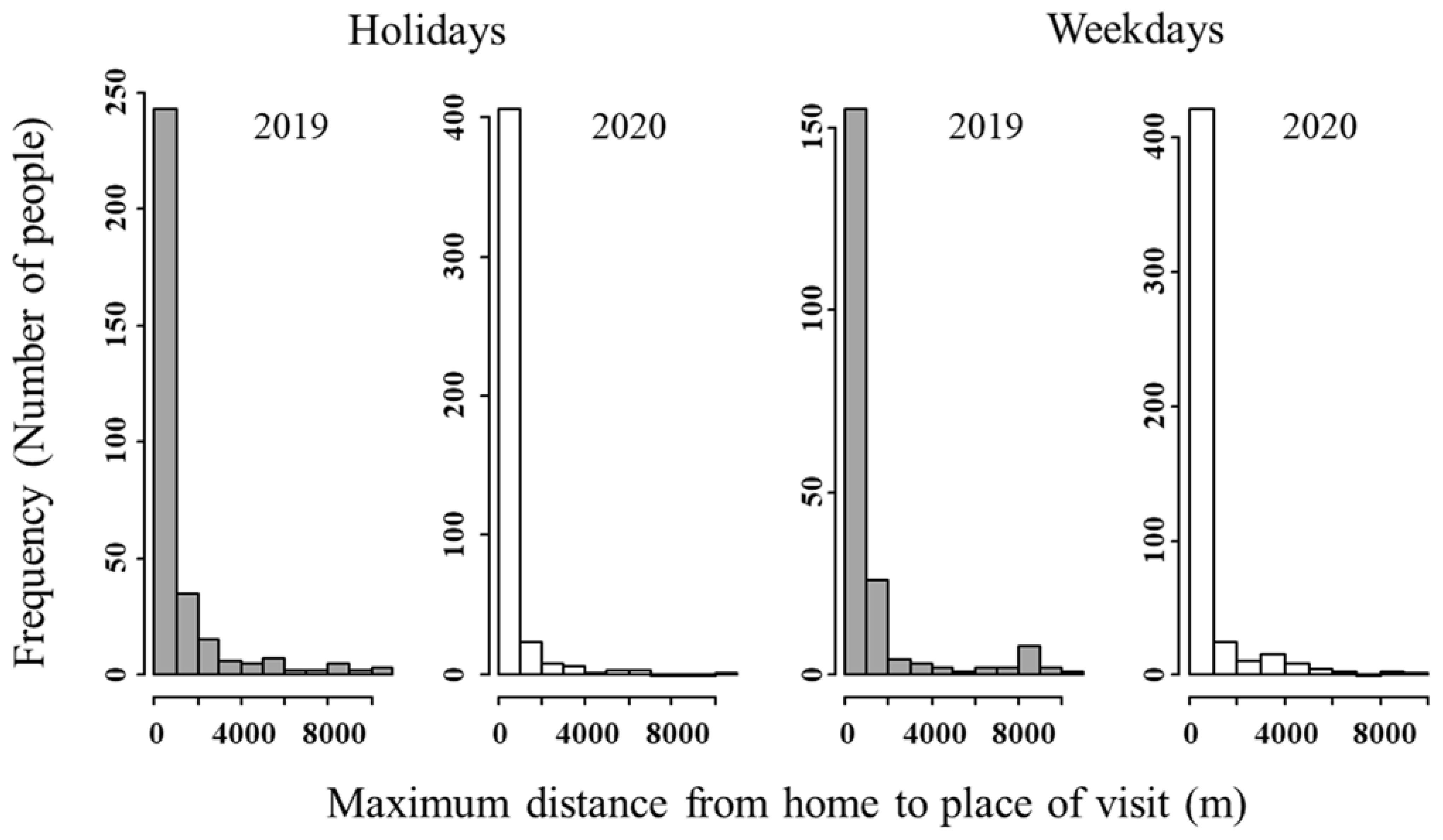

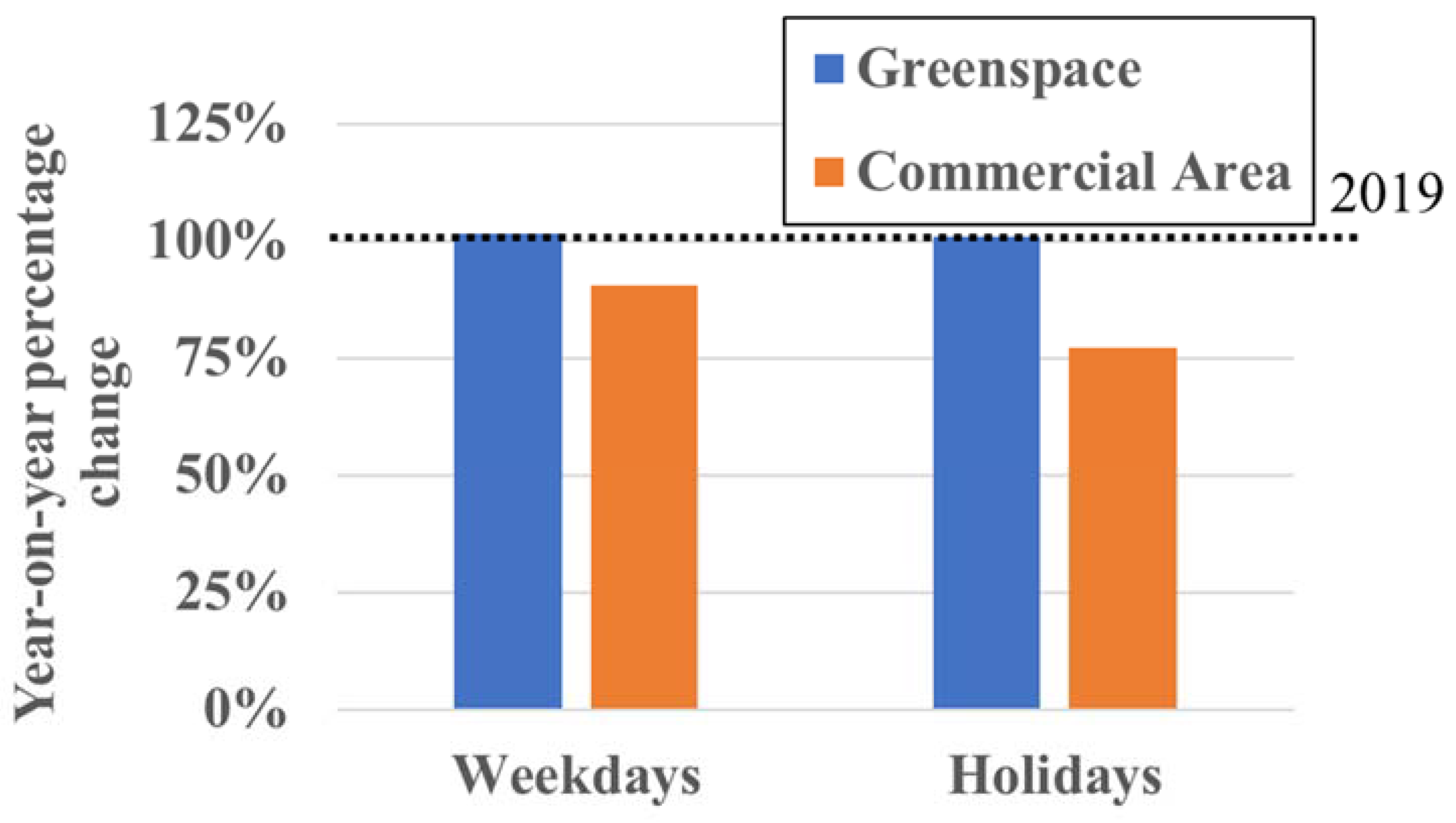
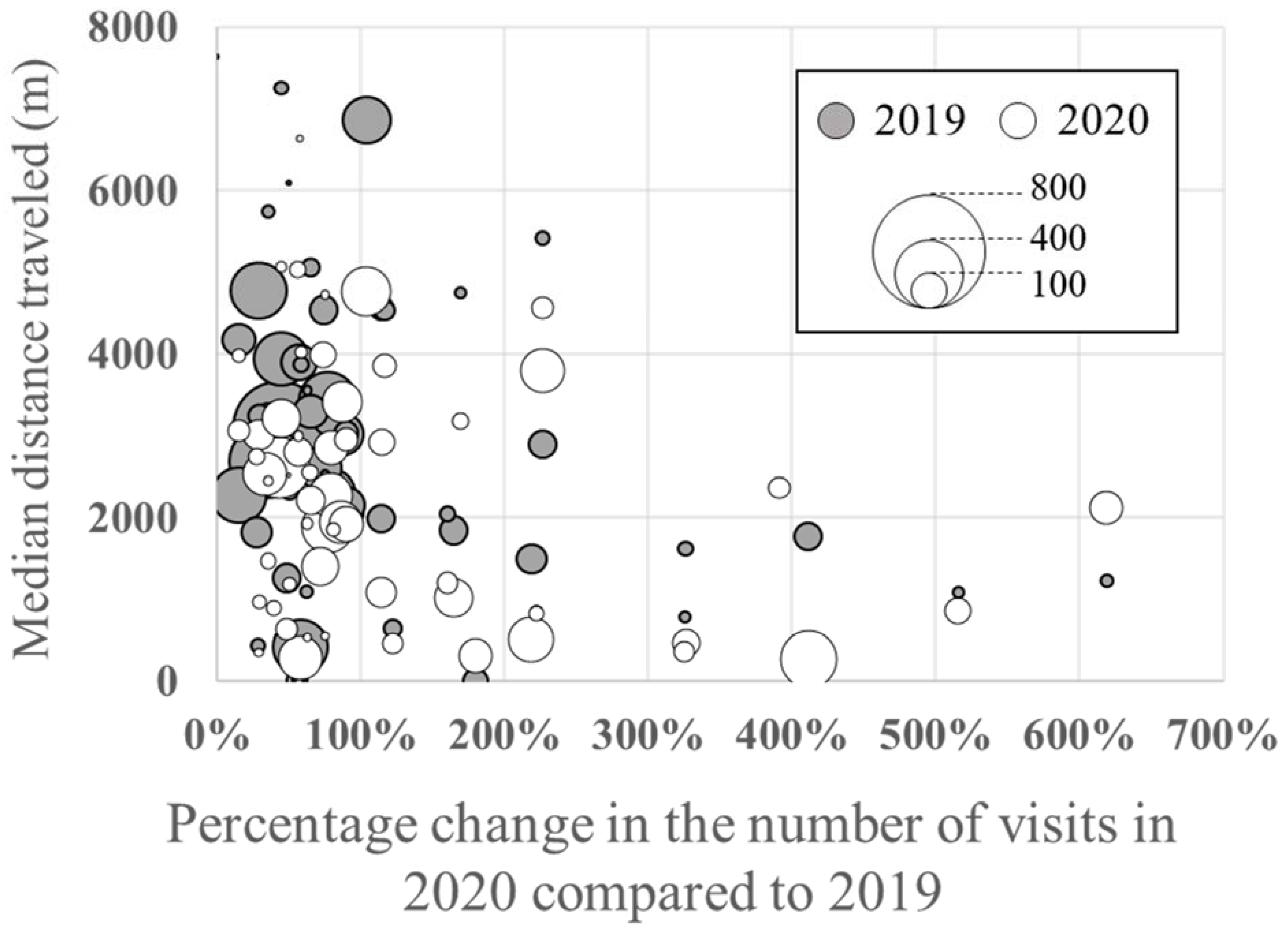
| Source | df | Sum Sq | Mean Sq | F Value | p Value |
|---|---|---|---|---|---|
| Year | 1 | 69,679 | 69,679 | 2648 | <2 × 10−16 *** |
| Type of Day (Year) | 1 | 50,299 | 50,299 | 1911 | <2 × 10−16 *** |
| Residuals | 80,205 | 2,110,650 | 26 |
| Source | df | Sum Sq | Mean Sq | F Value | p Value |
|---|---|---|---|---|---|
| Year | 1 | 803,900,000 | 803,873,362 | 7335 | <2 × 10−16 *** |
| Type of Day (Year) | 1 | 587,100,000 | 587,103,496 | 5357 | <2 × 10−16 *** |
| Residuals | 80,205 | 8,790,000,000 | 109,591 |
Publisher’s Note: MDPI stays neutral with regard to jurisdictional claims in published maps and institutional affiliations. |
© 2022 by the authors. Licensee MDPI, Basel, Switzerland. This article is an open access article distributed under the terms and conditions of the Creative Commons Attribution (CC BY) license (https://creativecommons.org/licenses/by/4.0/).
Share and Cite
Ueno, Y.; Kato, S.; Mase, T.; Funamoto, Y.; Hasegawa, K. Human Flow Dataset Reveals Changes in Citizens’ Outing Behaviors including Greenspace Visits before and during the First Wave of the COVID-19 Pandemic in Kanazawa, Japan. Int. J. Environ. Res. Public Health 2022, 19, 8728. https://doi.org/10.3390/ijerph19148728
Ueno Y, Kato S, Mase T, Funamoto Y, Hasegawa K. Human Flow Dataset Reveals Changes in Citizens’ Outing Behaviors including Greenspace Visits before and during the First Wave of the COVID-19 Pandemic in Kanazawa, Japan. International Journal of Environmental Research and Public Health. 2022; 19(14):8728. https://doi.org/10.3390/ijerph19148728
Chicago/Turabian StyleUeno, Yusuke, Sadahisa Kato, Tomoka Mase, Yoji Funamoto, and Keiichi Hasegawa. 2022. "Human Flow Dataset Reveals Changes in Citizens’ Outing Behaviors including Greenspace Visits before and during the First Wave of the COVID-19 Pandemic in Kanazawa, Japan" International Journal of Environmental Research and Public Health 19, no. 14: 8728. https://doi.org/10.3390/ijerph19148728
APA StyleUeno, Y., Kato, S., Mase, T., Funamoto, Y., & Hasegawa, K. (2022). Human Flow Dataset Reveals Changes in Citizens’ Outing Behaviors including Greenspace Visits before and during the First Wave of the COVID-19 Pandemic in Kanazawa, Japan. International Journal of Environmental Research and Public Health, 19(14), 8728. https://doi.org/10.3390/ijerph19148728






